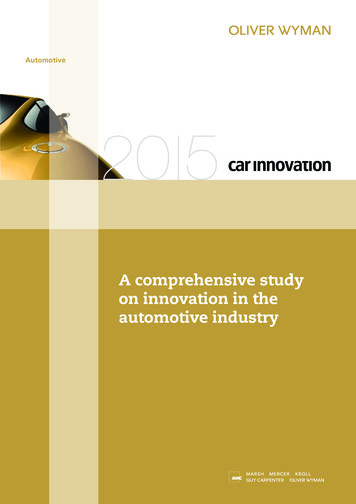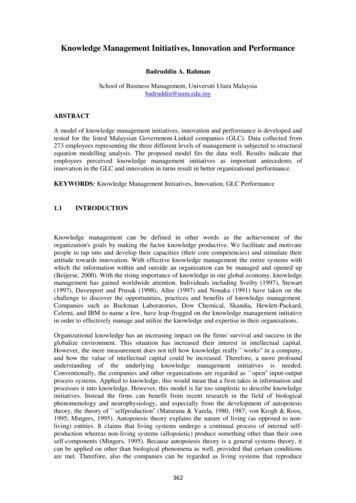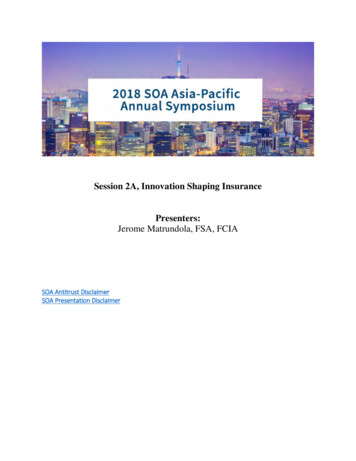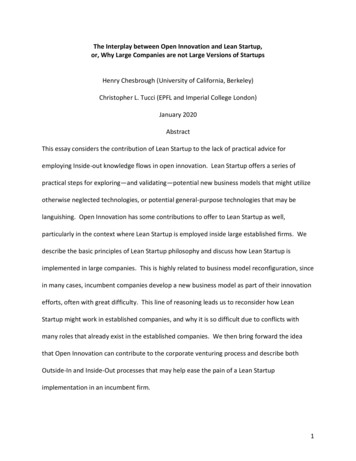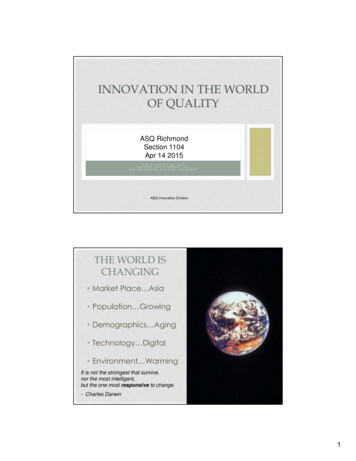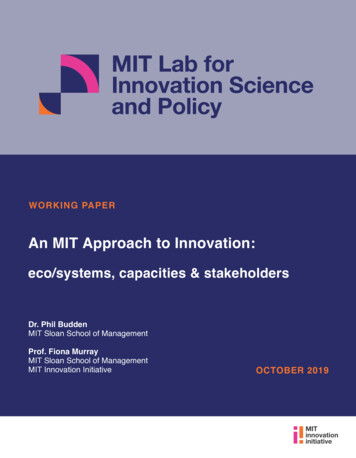
Transcription
I N N O V A A T I O N1www.ibscdc.org
ITC’s E-Choupal: A Mirage of thePoor?E-Choupal is a novel initiative of ITCLimited (ITC), an Indian conglomerate,to improve its marketing channel inagriculture. It has its roots in ProjectSymphony – a pilot project launched in1999 to organise ITC’s agri business. Thebusiness model was designed toaccommodate farmers, intermediaries inthe traditional model and the companythrough information technology. The mainobjective of e-Choupal is dissemination anddisintermediation of price information. EChoupal deals with various products – feedingredients, food grains, edible nuts,processed fruits and marine products. Ithas extended the basket to horticulture andspices. As of 2007, e-Choupal operates inthe Indian states of Madhya Pradesh,Haryana, Uttaranchal, Karnataka, AndhraPradesh, Uttar Pradesh, Maharashtra,Kerala and Rajasthan. By 2012, ITC hasplanned to expand the project to 15 statesin India reaching 100,000 villages. ITChas launched Choupal Sagar, a multipurpose retail outlet in the rural areas withplans to open 700 such rural malls by 2012.ITC-IBD has initiated a new store formatChoupal Fresh Cash & Carry Stores forretailing fresh fruits and vegetables acrossmajor Indian cities. ITC has piloted aproject with a three-part combo moduleto manage the entire value chain. It isharnessing the technology platform forimprovement. The biggest test for ITC isthe aggressive scaling up of its operationsto successfully reach its vision.Pedagogical Objectives To understand the structure of the eChoupal network To discuss the benefits derived out ofthe e-Choupal network To discuss the future of the e-Choupalin terms of scalability.IndustryReference No.Year of Pub.Teaching NoteStruc.Assign.Rural Choupal;CorporateSocialResponsibility; ITC Limited; Farmers;India; Rural e-Business; Internet Kiosks;Value Chain Intermediaries; Choupal Sagar;Innovation Management Case Studies;Choupal Fresh; Rural Empowerment;Business Model; Supply Chain ManagementWill Harry Potter’s Magic Work forUniversal Studios Theme Parks?Universal Parks and Resorts, a division ofUniversal Studios Inc., one of the leading2www.ibscdc.orgAmerican studios declared in May 2007that it had obtained the rights fordeveloping a theme park based on theextremely successful character of thepopular culture Harry Potter in US, UKand all over the world. Walt Disney parksand resorts have also tried to get the rightsfor Harry Potter theme park but failed tostrike a deal with the creator of the HarryPotter character, J.K. Rowling. Universaland Disney have been competing in theentertainment industry for many years, andWalt Disney had been a leader in themeparks. Though a tough competitor toDisney in large theme parks segment;emulating Disney’s strategies, Universalwas facing decline in the number ofattendants to its theme parks since 2004.With the announcement of a Harry Pottertheme park planned to be ready by 2009,industry experts anticipated Universal togain a momentum over Disney. It remainsto be seen how Universal would leverageon the successful brand of Harry Potter tobeat Disney in the theme park segment.Pedagogical Objectives To understand the strategies of WaltDisney company To analyse how Disney usedmerchandising and cross-promotion toachieve success in theme parks To discuss the competition betweenUniversal and Disney To analyse the huge success of the “HarryPotter” phenomenon To discuss the challenges lying ahead forUniversal that takes on the “HarryPotter” brand further To debate the potential strategies to beused by Universal as against Disney’s.IndustryReference No.Year of Pub.Teaching NoteStruc.Assign.Theme ParksINM0107B2008AvailableAvailableKeywordsUS Theme Parks Industry; Harry Potter;Universal Studios; Disney; WarnerBrothers; Theme Parks; InnovationManagement Case Study; Entertainment;Marketing; Brand Extensions; Movies andBooks; J.K. Rowling; Entertainment; BrandLeverage, Brand Value, CompetitionInnovate for Growth: Immelt’sStrategy for GEJeffrey Immelt became Chairman and CEOof GE in September 2001. Succeeding JackWelch was a challenge in itself, but insteadof trying to emulate Welch’s time testedcorporate management philosophies,Immelt charted his own leadership styleand brought about a cultural revolution inGE. Expectations were high and thechallenges were many. Immelt had to faceseveral challenges. He had to provideleadership and lend vision to a large, diverseconglomerate like GE in the post 9/11volatile global business scenario. He alsohad to shift the company’s focus towardsinnovation and customer centricity inaddition to posting continued growth in asluggish economy. The case study discussesImmelt’s innovation and customer centricapproach and the impact it would have onthe company.Pedagogical Objectives To discuss the role of innovation in GE To discuss the different leadership styleand its impact at GE.IndustryReference No.Year of Pub.Teaching NoteStruc.Assign.Automobile ership style; situational leadership;Innovative strategies; Jack Welch; culturalrevolution; organic growth; challenges;share price; six sigma; InnovationManagement Case Study; GE Global; workout plan; sluggish economic market;innovationFox Business Network (FBN) –Talking Business to the CommonMan?In 2007, News Corporation owned by themedia mogul, Rupert Murdoch launched anexclusive channel, Fox Business Network(FBN). The new channel was different fromCNBC which had a strong foothold in thebusiness news market. FBN differentiateditself by offering business news to thecommon man and kept away from the eliteand the serious audience served by CNBC.By choosing a different audience, was FBNbypassing direct confrontation with themarket leader? Would serving themainstream audience help FBN sustain inthe long run?Pedagogical Objectives To analyse the competitive scenario ofthe business news market in the US To analyse the scope of differentiatingits market entry and performance byusing bypass attack strategies To analyse whether the competitivestrategies adopted by FBN be successfuland payoff in the long-run?
Fox Business News; CNBC; Bloomberg; Bypass market entry startegy; innovativeprogramming; NBCU; Business News;Financial News; Common Man; Naked CowBoy; Innovation Management Case Study;CNNBabaJob.com, The Indian SocialNetworking Start-up:Differentiating with the Bottom ofthe PyramidBabaJob.com, a Bangalore-based start-up,a unique Internet site that providesemployment to the poor through theconcept of online social networking. Theidea is to help the highly unorganised poorworkforce of the economy like maids,helpers, drivers, cooks, etc. The case notonly gives the wider view of this but alsohighlights various issues, restricting themember users to integrate them with thegrowing popularity of online socialnetworking. It illustrates the process bywhich an illiterate gets job through the helpof a mentor, and in the process the mentorgets rewarded for every jobseekersacceptance of job.Pedagogical ObjectivesThe case is structured to let the studentsanalyse and understand: To understand the dynamics of the socialnetworking market To understand the business model ofBabaJob.com To understand the visibility of trust andrisks associated with BabaJob.com To understand the importance ofappropriate business model in the socialnetworking space.IndustryReference No.Year of Pub.Teaching NoteStruc.Assign.Social gle vs Baidu.com (A): TheExportability of Google'sBusiness ModelGoogle is the most visited search enginewith a 62.4% market share and is the mostprofitable with 16.5 billion revenues in2007. The company has seen stupendoussuccess in a short span of time. ItsPageRank technology, AdWords andAdSense advertising programmes andproduct line-up has ensured that it staysahead of competition. The changes it hasmade to its business model signify itsbusiness depth. Google, after conqueringthe US market, started offering its servicesin other countries - through various searchinterface languages and in a number of localdomains. Google's rise and profitability hasmade other international Internet giantslike Yahoo! and Microsoft realise, albeitlate, the lucrativeness of search. They aremaking efforts to grow in this direction.Google's growth has attracted morecompetitors and complaints. This case, thefirst in the series Google vs Baidu.com,details the rise and growth of Internetsearch engines. Providing a brief historicaloutlook, it focuses on how Google throughits innovative technology rose to successvery soon. Revenue-earning models ofInternet companies are dealt in greaterdetail, with focus on how Google makesmoney. The case also details Google's addons to its products and services, for ensuringgrowth and sustainability. This case helpsdiscuss how Google has grown over theyears. What has been the company'sstrategy? What is its business model andwhat is so unique about it? Finally, itquestions whether this business model isexportable - can Google use the 'one sizefits all' approach to its business model?Pedagogical ObjectivesThe case is structured to let the studentsanalyse and understand: Search engines' business and revenuemodels Google's business model and otherfactors, like its technology, products andservices, which have led to its success TherationalebehindInternetcompanies targeting overseas markets Whether search engines business modelsand that of Google is exportable?IndustrySocial Networking; Dynamics of onlinebusiness; BabaJob.com; Business andRevenue Model; Corporate SocialResponsibility; Organised and UnorganisedEmployment; Sean Blagsvedt; InnovationManagement Case Study; Critical successfactors of e-commerce; Strategies ofBabaJob.com; Bubble 2.0Reference No.Year of Pub.Teaching NoteStruc.Assign.Internet Search & wordsGoogle; Baidu.com; China's Search EngineMarket; Business Model; Globalisation andLocalisation; CAGE Frame Work; AllianceStrategies; Acquisitions and Partnerships;Chinese Google; Government BusinessEnvironment; Internet Censorship; OnlineAdvertising; Innovation Management CaseStudy; International Business; LegalEnvironment and RegulationsDell Business Model (B): A Casefor Business Model InnovationDell Inc. was the world's second largest PCCompany in 2007 in terms of market share.Dell was the market leader in 2004, but itlost its position to Hewlett-Packardfollowing changing competitive dynamicsin the PC industry. To regain its leadershipposition, Dell started selling its PCs throughretail chains. This was in sharp contrast toDell's legendary business model of sellingcustomised PCs directly to customers. Dellhad attempted to sell through retail chainspreviously in the 1990s, but abandoned itdue to low profit margins. The case discussesthe concept of 'active inertia', which resultsfrom an inappropriate response to changingcompetitive dynamics, and how Dell fellinto the trap of 'active inertia'. The casealso discusses internal and externalchallenges facing Dell in its attempt toregain its leadership position in the PCindustry.I N N O V A A T I O NIndustryReference No.Year of Pub.Teaching NoteStruc.Assign.Pedagogical Objectives How important is modifying a businessmodel for an organisation's success? To study the growing importance of theretail segment compared to the businesssegment.IndustryReference No.Year of Pub.Teaching NoteStruc.Assign.Personal l; Computers; Business Model; MichaelDell; PC retailing; Segmenting; Targeting;Positioning; Innovation Management CaseStudy; Active Inertia; Hewlett-Packard;Compaq; Lenovo; Transformation;Strategic Inflection Point; SIPDell Business Model (A):Strategic Inflection Points in thePC IndustryDell Inc. was the second largest PCCompany in 2007 in terms of global marketshare. The success of Dell was largelyattributable to its direct selling businessmodel, which was suitable for corporatebuyers and bulk purchasers. Dell had an inbuilt advantage of lower costs due to itshighly efficient manufacturing operationswww.ibscdc.org3
and supply chain management efficiencies.However, with the changing competitivedynamics, Dell was losing its costleadership in the industry. Dell's costadvantage against its competitors waseroding as competitors were followingpractices like mass manufacturing and justin-time inventory management. AfterHewlett-Packard became the market leaderin 2007, Dell was considering variousoptions to sustain and regain its leadingposition in the PC industry.Pedagogical Objectives To understand the concept of businessmodel innovation in the context of anorganisation's success To understand, how the new competitivedynamics when unaddressed wouldundermine the success of existingbusiness models.IndustryReference No.Year of Pub.Teaching NoteStruc.Assign.Personal l; Computers; Business Model; MichaelDell; PC retailing; Segmenting; Targeting;Positioning; Innovation Management CaseStudy; Active Inertia; Hewlett-Packard;Compaq; Lenovo; Transformation;Strategic Inflection Point; SIPMobile Phones: The Advent of aNew Advertising MediumMarketers are constantly looking forinnovative ways and channels to sendmarketing messages. The attention ofmarketers swung towards mobile phonesas an innovative medium for this purpose,due to their mass usage. Mobile phonepenetration around the world reached morethan 2 billion as of 2008. This led to use ofshort messaging, mobile search advertising,and video files as advertisement platformsfor reaching consumers. Most consumersaround the world accept such messages,according to their perceived relevance andoffers provided. Mobile phone advertisingplatforms have evolved, depending uponthe features of mobile phones thatconsumers use. The case analyses howmobile phones can be used better formarketing communication.Study; Strategies of P&G in Mexico;Innovation in Emerging MarketsMobile Phones; Advertising; InnovationManagement Case Study; Competiton;Mobile Serach Users; SMS; MMSIn 2006, Logitech International SA(Logitech), the Swiss public companywhich was established in 1981, recordedrevenue of 1,797 million. Logitech, whichstarted with the OEM sector, expandedthrough its retail business. It has diverseproducts in computer peripherals andcommands leading positions in all itsproduct categories such as audio, video, PCnavigation, Internet communication,music, and gaming devices. Logitech hasbeen a highly innovative company, with alist of more than 65 industry ‘firsts’. Itlaunched more than 130 new productsduring 2006. But it faced stiff competitionfrom industry giants like Microsoft. In thisscenario, can Logitech sustain itscompetitive edge by just being innovative?Will it be successful in keeping pace withtechnology and market, to retain its leadingpositions in its product categories?Logitech: Competing throughInnovationKeywordsP&G in Mexico: Profiting fromProduct and MarketingInnovations?Leading consumer packaged goodsmanufacturer Procter & Gamble (P&G) hasan impressive history of successfullylaunching a vast array of new products.With developed world markets becomingincreasingly saturated, multinationalcorporations have turned to emergingmarkets like India, China, and Mexico.Realising the potential of consumers in theemerging markets, major MNCs arepenetrating the growing low-incomesegments. But the dynamics and theconsumer behaviour in these markets arequite different from the developed markets.According to many experts, the strategiesthat hold well in developed markets fail indeveloping markets. However, P&G, withits long presence, has had tremendoussuccess in Mexico through its product andmarketing innovations.Pedagogical Objectives To discuss product profilesegmentation statistics of P&Gand To discuss P&G's shift in its businessmodel from serving wealthiest customersin developed countries to low-incomeconsumers in emerging markets To identify various opportunities andchallenges for companies in emergingmarkets To discuss the product and marketinginnovation strategies of P&G in Mexico To debate on the sustainability of P&G'sstrategy of serving low-incomeconsumers in the long run.IndustryReference No.Year of Pub.Teaching Pedagogical ObjectivesKeywords To understand the opportunities formarketing communication throughmobile phone as a mediumPopulation and Income levels of Peoplein Latin America; Fortune at the Bottomof the Pyramid; Mexican RetailingIndustry; Potential and Challenges fromEmerging Markets; Consumer Behaviourin Mexico; Innovation Management Case To discuss how mobile phoneadvertisements should be designedconsidering how consumers react toadvertisements through mobile phones.4Mobile ce No.Year of Pub.Teaching NoteStruc.Assign.www.ibscdc.orgPedagogical Objectives To understand the changing dynamicsof computer peripherals industry To understand how innovation drivescompetition in the industry To discuss about various competitiveadvantages of Logitech To get an awareness of Logitech’sproducts vis-à-vis competition To analyse whether innovation cansustain growth for Logitech.IndustryReference No.Year of Pub.Teaching NoteStruc.Assign.Computer omputer Peripherals Industry; LogitechInternational SA; OEM; Innovation; NewProduct Introductions; TechnologicalInnovation; MX Revolution; PC Industry;Microsoft; EPFL Incubator; Logitech;Daniel Borel; Innovation ManagementCase Study; Growth Engines; OrganicGrowth Creative TechnologyM&M’s Candy’s InnovativeMarketing StrategiesIn the high-tech culture of the newmillennium, M&M’s Candy has foughtdiligently to stay cool, contemporary andrelevant to consumers in the 21st century.It has faced incessant challenges fromcompetitive brands as well as social
The case can be used to discuss thedynamics of the candy industry, M&M’sbrand strategy including brand merchandiseand brand characters and the use of retailchannels, advertainment and Internetmarketing to build personalizedrelationship with the customers.Pedagogical Objectives To discuss the dynamics of the candyindustry To analyse M&M’s brand strategyincluding brand merchandise and brandcharacters To discuss the use of retail channels,advertainment and internet marketingto build personalised relationship withthe customers.IndustryReference No.Year of Pub.Teaching NoteStruc.Assign.Confetionary IndustryINM0097P2007Not AvailableNot AvailableKeywordsMars; Brand Strategy; Advertisement;Innovation Management Case Study; BrandCharacter; Brand Personality; BrandRevitalisation; Mini Brand; ProductpersonalisationHonda’s Green TechnologyStrategy in the US Auto MarketJapan based Honda Motor Company is aleading global automobile manufacturer. Itmanufactures a variety of products likesmall general-purpose engines, cars,motorcycles, trucks, scooters. Since theearly 2000s the volatility in fuel pricesand greater environmental awarenessforced many consumers to look for fuelefficient alternatives. It has led to increasedcompetition in the alternative fuel vehiclesegment. Honda has found its one fuelstrategy risky and decided to focus ontechnologies like clean diesels, hybrids andfuel cells which give it more flexibility.The case study discusses Honda’s initiativesin developing cleaner and fuel efficientengines and gaining market share in thealternative fuel vehicle segment.Pedagogical Objectives The case discusses Honda’s initiative todevelop cleaner and fuel efficient enginesto fight against the volatility in fuelprices and to target the consumerslooking for the fuel efficient alternatives It also discusses the company’s strategyto gain market share in the alternativefuel vehicle segment.IndustryReference No.Year of Pub.Teaching NoteStruc.Assign.AutomobileINM0096P2007Not AvailableNot AvailableKeywordsHonda; Dream D-type engine; C1000 supercub; S-500; N-600 sedan; Honda Accord;Honda Civic; VTEC engines; InnovationManagement Case Study; Environmentalprotection Agency; Euro 5 emission norms;Alternative fuel vehicles; DOHC dieselengine; i- CTDi engine; IMA hybrid system;honda FCXDaimlerChrysler’s Compass SUV:Softening The Tough JeepJeep was an automobile brand ofDaimlerChrysler (DC) which was knownfor its rugged looks and agile off-roadperformance. It was one of the Chryslersubsidiaries and became a part ofDaimlerChrysler when Daimler-Benzmerged with the Chrysler Corporation in1998. Since its inception in 1941 Jeep haddominated sport utility vehicle (SUV)market for almost 65 years. Jeep wasfamous worldwide for its rough and toughlooks and it was hugely popular among theadventure friendly people. By 2006 salesof full-size SUVs were plummeting onregular basis and automakers were beginningto admit that a shift of market was almostinevitable. Several companies werethinking of new products, car-based SUVbeing one of them. DC was among them,and was about to take a new direction bylaunching its first car-based SUV whichemphasized on on-road performance ratherthan boulder-hopping off-road feats.Compass was Jeep’s first car-based SUV andit was the Jeep’s new initiative of focusingon-road performance. The managementof Jeep realized that they needed to appealto a wide range of customers and at thesame time they also wanted to preserve its“rough-and-ready” image. DC wascompeting for Jeep’s success with thephilosophy of expanding as well asdiversifying.This case deals with promotion of the newbrand ‘Jeep Compass’ as the managementhad planned to spend an estimated amountof US 75 million for the brand promotionand the acceptance level of new Jeepamong the common people.Pedagogical Objectives To understand the efforts made by DCto launch and promote ‘Jeep Compass To analyse how DC attempted to changeJeep’s traditional rough & tough image To get an idea of the global sports utilitymarket (SUV) market To discuss whether the new, ‘softer’, Jeepwould appeal to the customers.IndustryReference No.Year of Pub.Teaching NoteStruc.Assign.AutomobileINM0095K2006Not AvailableNot AvailableI N N O V A A T I O Npressures encouraging consumers to reducecandy consumption. But its main challengeis keeping the brand simple, relevant toconsumersandyetmaintaininggrowth.Over the years, colour, brandpersonalities, globally recognisablepackaging, the 'melt in your mouth, not inyour hand' slogan and the distinctive 'M'on each candy - all have played animportant role in raising the brand to aniconic status. Carrying on the spirit of itsearlier marketing initiatives, M&M’s hasdecided to freshen up the brand andstrengthen the emotional bonds with itsloyal customers by leveraging thecompelling equities of colour and fun tocreate consumer interest.KeywordsDaimlerChrysler (DC); Jeep; Compass;Sports Utility Vehicle (SUV); DaimlerBenz; Chrysler; Diversifying; Marque;Global SUV market; Product launch;Innovation Management Case Study; Brandpromotion; Rugged looks; Car based SUV;Softer Jeep; Off-road performanceIndian Railways – IT Innovationsin Passenger ServicesThe Indian Railways’ operated in a highlycomplex environment that made itimperative for its operations to becontinuously updated with timely andaccurate information to a variety ofbusiness concerns. Further, the optimumutilisation of the available resourcesdemanded deployment of a robustinfrastructure through implementation ofinnovative and economical technologies.This case provides the reader an insightinto the various cost-saving innovationsthat were adopted by IR in improving andadvancing their passenger services. Theprogressive implementation of IT servedas a thrust towards better responsivenessto the rising passenger demands. Thecommunication infrastructure that IR builtup over the years not only helped it catereffectively to the ascending customer needsbut also opened new avenues for revenuegeneration. It augmented its revenues andalso helped it cut down surplus expendituresthrough better utilisation of resources byway of improved demand analysis, bettermanagement of coaches and efficientutilisation of railway tracks.Pedagogical Objectives To discuss the successive ITimplementations at IR and how theyhelp IR to cut cost and increaseefficiencywww.ibscdc.org5
To analyse how IT is helping thepassengers in better utilising the railway'sservices.IndustryReference No.Year of Pub.Teaching NoteStruc.Assign.TransportINM0093K2007Not AvailableNot AvailableKeywordsIndian Railways; Smithsonian Awards; EDP(electronic data processing); Impress;Concert; Centre for Railways InformationSystems (CRIS); CML; PassengerReservation System (PRS); IntegratedVoice Response System (IVRS); UnreservedTicketing Service (UTS); InnovationManagement Case Study; e-TicketDell: From a Low Cost PC Makerto an Innovative CompanyDuring the late 80s, Michael Dell and hiscompany, Dell Inc., revolutionized theglobal PC market by the latter’s ‘DellDirect Business Model’, where iteliminated all kinds of middlemen anddirectly supplied customized PCs to thecustomers. For the last two decades, thecompany continued to be the market leaderin the small household PC segment.However, after enjoying the supremacy fortwo decades since 2005, it started facingcompetition. August 2006 was the cruelestmonth for Dell as the company’s bottomline experienced an unprecedented decline.The company’s revenue and profit failedto match the expectations. Besides, it hadto write off US 450 million (mn) for theinstallation of defective capacitors in itscomputers and opt for workforcealignment. It also recalled lithium batteriesmanufactured by Sony from its laptop. Theanalysts were thus, skeptical about thefuture of the organization. The companywas termed as less innovative than itscompetitors as it failed to launch innovativeproducts in the market. To be on thegrowth trajectory again, it planned to enterinto the consumer electronics segment. Butthe analysts were doubtful about the successof Dell’s ‘Direct Business Model’ in theconsumer electronics segment. The casedeals with Dell’s business model, viablealternative of Dell’s business model and itssuccess in the consumer electronicssegment. It provides a scope for discussingwhether the turnaround strategy of Dellwould be successful and about the scenarioof global PC industry and global consumerelectronics market.Pedagogical Objectives To discuss how Dell revolutionized theglobal PC market To analyse Dell’s Direct Business Model To understand the global PC industry6www.ibscdc.org To discuss the challenges faced by DellPedagogical Objectives To debatestrategies. To understand about onsite and offshoremodels for delivering software servicesIndustryReference No.Year of Pub.Teaching NoteStruc.Assign.onDell’sturnaroundPersonal ComputersINM0092K2007Not AvailableNot AvailableKeywordsDell Inc; Apple; Dell business model;Personal computer; US computer industry;IBM (International Business MachinesCorporation); Server; Printer; InnovationManagement Case Study; Notepad; Sony;Graphical user interface; GatewayComputers; Premier Page web page;Product recallsThe Implementation of anImproved Global DeliveryModel in Infosys: Will itSucceed?Infosys, a software development companyin India, initially provided onsite serviceto its global clients. This being anexpensive proposition, the companydecided to complete projects at its Indianoffshore development centers and thenimplement them at the clients’ places. Thiswas also a challenge as there was no serviceprovider at the clients’ locations, causinga deterrent to the progress of projects.Besides, miscommunication added to thedelay of project completion. To serve itsclients effectively and in time, Infosysdecided to open proximity centers closeto the clients’ locations. In the late 1990s,due to stiff competition from IBM, Wiproand TCS, Infosys decided to adopt theGlobal Delivery Model (GDM), which wasbased on the principle of taking work whereit could be done best in an economicalmanner and with the least amount ofacceptable risk. In 2005 Infosys’ revenuestood at 1,592 million.Infosys found that IBM, Accenture, TCSand Wipro had also adapted GDM. Industryobservers felt that GDM was a standardizedIT model but had no competitiveadvantage. To combat competition and todifferentiate itself from other Global ITgiants, Infosys started working on GDM2.0 and called it the “CollaborativeDistributed Delivery Model” (CDDM).To implement the new GDM, Infosys hadto set up more offshore developmentcenters around the globe. To succeed in itsefforts Infosys decided to acquirecompanies around the globe.Would Infosys succeed in gaining thecompetitiveadvantageandthedifferentiator that it hoped to achieve withits improved GDM? To understand why and how GlobalDelivery Model is used by softwarecompanies like Infosys to enhanceservice to its clients and to implementKnowledge Management across thecompany To understand how Infosys changed itsstrategy to be one up on its competitors.IndustryReference No.Year of Pub.Teaching NoteStruc.Assign.Software IndustryINM0091B2006Not AvailableNot AvailableKeywordsOnsite Model; Offshore Model; GlobalDelivery Model (GDM); ProcessArchitecture; Innovation ManagementCase Study; HR Recruitment; Managerialfunctions at Infosys; Knowledgemanagement;SoftwareIndustryCompetition; Collaborative DistributedDelivery ModelWhirlpool: Redefining InnovationThe year 2005 had proved to be a year ofexceptional achievements for the world’snumber one home appliance brandcompany, Whirlpool. It had achievedrecord net earnings of 422 million onrecord sales revenues of 14.3 billion, whichhad in turn, propelled the company’s shareprice to an all-time high of 92.64 by April2006.Much of Whirlpool's performance wasattributed to the new products and featuresin
Advertising; Innovation Management Case Study; International Business; Legal Environment and Regulations Dell Business Model (B): A Case for Business Model Innovation Dell Inc. was the world's second largest PC Company in 2007 in terms of market share. Dell was the market le



